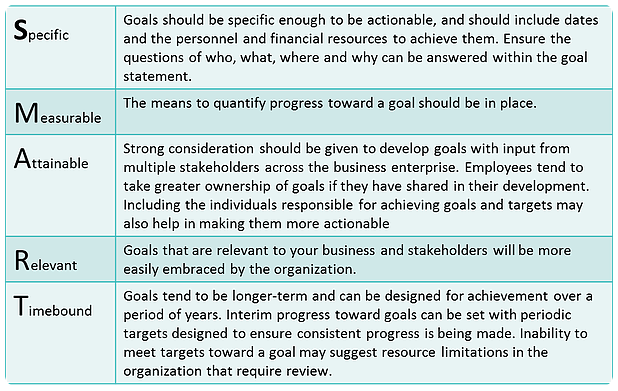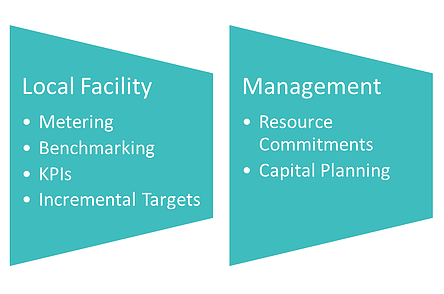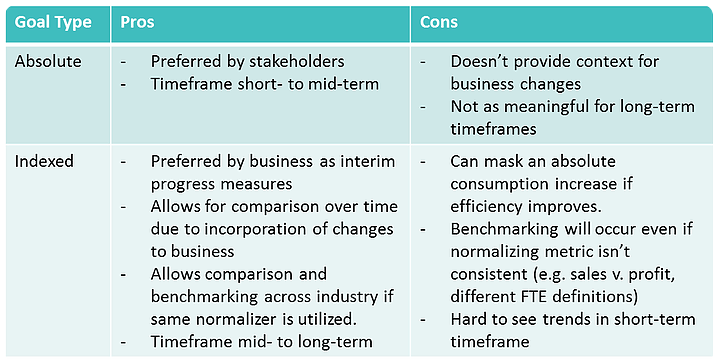Goals & Targets
Energy Management
Having defined data collection, established specific Key Performance Indicators (KPIs), and benchmarked performance it is important to also consider setting specific energy goals and targets. Setting goals and targets allows an organization to:
- Pursue deliberate reductions.
- Increase employee engagement and accountability.
- Quantify financial savings associated with pursuing set goals and targets.
- Track progress towards improving energy efficiency at a defined pace and over a set time frame.
Definitions
Goal – A long term vision of an organization’s energy management program, often tied to internal policy or strategy. Goals can be influenced by operational, financial or legal variables.
Target – A detailed, measurable and incremental step aligned to facilitate achieving a defined goal.
An organization needs to decide how best to determine and align energy goals within the overall company structure and resources. Goals surrounding energy will be influenced by how energy is managed and how efforts to improve performance are undertaken.
A common methodology widely used across multiple sectors is the SMART concept for goal and target setting. Each element of this methodology supports and complements the others.

Energy Goal Setting and Communication
Setting energy goals and targets allows for development and improvement of energy management practices beyond the business-as-usual case. Goals must be embraced by senior organizational management; however, success in meeting goals and targets is often less effective when driven by top-down implementation. Goals that are more heavily influenced by competitors in the marketplace focused on arbitrary or organic savings can be difficult to achieve as they are harder to envision and embrace by the organization.

Organizations should consider conducting a goal and target planning meeting with the affected internal stakeholders, comprised of a committee with energy management responsibilities. Larger organizations with multiple facilities may find a meeting such as this more valuable than smaller operations. Regardless of size, consideration should be given to the style of goal setting environment that would ultimately be most productive for the organization.
Personnel responsible for developing goals and targets should have current metering, KPI, and benchmarking data available to inform decisions. Targets and goals should not be arbitrary as data will inform what can be reasonably achieved. Knowledge of industry best practices and facility audits should also be incorporated into target development as appropriate.
Setting of incremental targets can be a useful strategy for informing a longer-term goal. Target setting can be most-effective when developed by the local facility. Development efforts led by the local facility tends to encourage awareness and buy-in at the local level from the beginning and may limit the degree of advocacy required by management during roll-out and implementation.

Granularity of targets will be influenced by the level of effort required to meet the stated goal(s). Setting targets at increasingly smaller increments will require the energy management system to be robust enough that metering, benchmarking and KPI data is available at the same level, or commitments are in place to provide those resources well before target dates are set.

Good targets include “stretch”, or ambitious performance beyond expectations. Development of stretch targets should be designed to drive innovation and can be used as a tool to challenge a business-as-usual mindset toward achieving targets and goals. However, stretch targets should not be so unreasonable that they discourage the level of innovative thinking or motivation required to achieve them. Companies must also be aware that it may be necessary to make special accommodations to standard business practices in order to make achievement of stretch goals possible.
Best Practices for Tracking Goal Performance
Tracking performance toward a goal can be accomplished through a system of meetings and daily to weekly operational reviews. The site energy management team should determine the content of what is reviewed, how frequently, and what to do when performance falls behind target.
Setting operational targets is an initial step toward making progress toward a goal; however, people with energy responsibilities need to be held accountable for performance and progress. Energy managers should be provided with sufficient data and context to be able to improve performance and explain deficiencies. Consumers of energy need to use and maintain the system and understand that information in operational reports is actionable. A more granular energy management system should have sufficiently granular business processes accompany it.
Absolute vs. Indexed Goals
A common challenge for many organizations when setting goals and targets is the debate about absolute (total consumption or use) versus indexed (normalized) metrics. The answer to this debate is very organizational specific as it depends upon business objectives and intended audiences for communicating performance. The following provides a general comparison in the form of pros and cons:
Setting operational targets is an initial step toward making progress toward a goal however, people with energy responsibilities need to be held accountable for performance and progress. Energy managers should be provided with sufficient data and context to be able to improve performance and explain deficiencies. Consumers of energy need to use and maintain the system and understand that information in operational reports is actionable. A more granular energy management system should have sufficiently granular business processes accompany it.

If you don’t know where you are going, you will likely end up somewhere else. Having clear energy goals and targets is critical.







